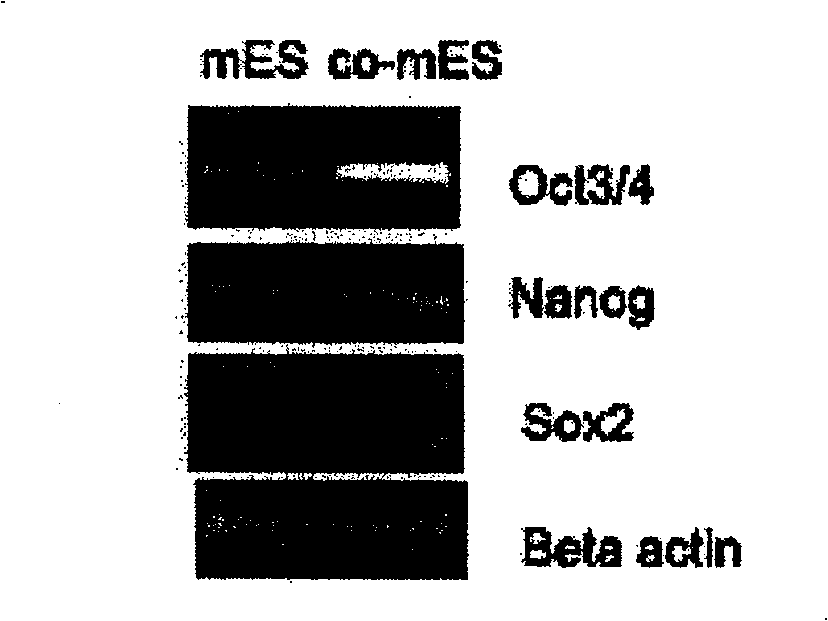Method for culturing mouse embryo stem cell and its dedicated culture medium
A technology of embryonic stem cells and mouse embryos, applied in embryonic cells, germ cells, tissue culture, etc., can solve the problems of lack of scientific research funds, limited life span of MEF, and inability to pass on for a long time, so as to maintain self-renewal and rapid value-added, which is important Application value, economic value, and effect of reduction in cultivation cost
- Summary
- Abstract
- Description
- Claims
- Application Information
AI Technical Summary
Problems solved by technology
Method used
Image
Examples
Embodiment 1
[0032] Embodiment 1, using the human umbilical vein endothelial cell line ECV-304 as trophoblast cells to culture mouse embryonic stem cells
[0033] 1. Preparation of ECV-304 trophoblast cells
[0034] 1. ECV-304 cell culture
[0035] Main experimental materials:
[0036] Cells: human umbilical vein endothelial cell line ECV-304 (Japan DSMZ Company, DSMZ no. ACC310), hereinafter referred to as ECV-304.
[0037] Cell culture medium: add calf serum and thioglycerol (MTG) in high-sugar DMEM (product of Hyclone Company, article number: SH30243.01), so that the mass percentage of calf serum is 10%, so that the thioglycerol The content of glycerin is 1.5×10 -4 mol / L.
[0038] Digestion solution: a solution obtained by adding 0.25% trypsin to 0.02% EDTA at a volume ratio of 1:1.
[0039] 2. Recovery of ECV-304 cells:
[0040] (1) Cell recovery: Take out the frozen cells from the frozen liquid nitrogen tank, and quickly place them in a water bath at 37°C-42°C to melt the cells ...
Embodiment 2
[0075] Example 2, using human bladder cancer epithelial cells T24 as trophoblast cells to culture mouse embryonic stem cells
[0076] 1. Preparation of T24 trophoblast cells
[0077] Except for the cells and cell culture medium in the experimental materials, other experimental materials and experimental methods are the same as Step 1 of Example 1.
[0078] Cells are human bladder cancer epithelial cells T24 (ATCC company of the United States, ATCC no.HTB-4 TM );
[0079] The cell culture medium is T24 cell culture medium: add fetal calf serum and thioglycerol (MTG) in high-sugar DMEM (product of Hyclone Company, article number: SH30243.01), so that the mass percentage of fetal calf serum is 20 %, so that the content of thioglycerol is 3.0×10 -4 mol / L.
[0080] 2. In vitro culture of established embryonic stem cells
[0081] Except that the trophoblast cells were human bladder cancer epithelial cells T24 and the cell culture medium was T24 cell culture medium, other experi...
Embodiment 3
[0083] Example 3. Detection of mES stemness marker molecules cultured with ECV-304 or human bladder cancer epithelial cells T24 as trophoblast cells.
[0084] 1. Reverse transcription polymerase chain reaction (RT-PCR) to detect the expression of mES stemness molecular markers at the mRNA level:
[0085] 1. Stemness molecules (marker molecules) of mouse embryonic stem cells: transcription factors Oct3 / 4, Nanog, Sox2.
[0086] 2. RT-PCR reaction primers: reverse transcription synthesis of cDNA using the universal primer OligodT, PCR amplification of the above gene primer sequences are: OctP1: 5'AATGCCGTGAAGTTGGAG3', OctP2: 5'GAAGCGACAGATGGTGGT3'; NanogP1: 5'GCCCTGATTCTTCTACCA3', NanogP2: 5'AGATGCGTTCACCAGATAG3'; Sox2P1: 5'CCCGTGGTTACCTTCTTCC3', Sox2P2: 5'TTTCTCCAGTTCGCAGTCC3'; internal reference gene β-actin P1: 5'GCTGTCCCTGTATGCCTCT3', β-actin P 5'TTGATGTCACGCACGATTT3'. Wherein, OctP1 and OctP2 are primers for amplifying the transcription factor Oct3 / 4, NanogP1 and NanogP2 ...
PUM
 Login to View More
Login to View More Abstract
Description
Claims
Application Information
 Login to View More
Login to View More - R&D
- Intellectual Property
- Life Sciences
- Materials
- Tech Scout
- Unparalleled Data Quality
- Higher Quality Content
- 60% Fewer Hallucinations
Browse by: Latest US Patents, China's latest patents, Technical Efficacy Thesaurus, Application Domain, Technology Topic, Popular Technical Reports.
© 2025 PatSnap. All rights reserved.Legal|Privacy policy|Modern Slavery Act Transparency Statement|Sitemap|About US| Contact US: help@patsnap.com



